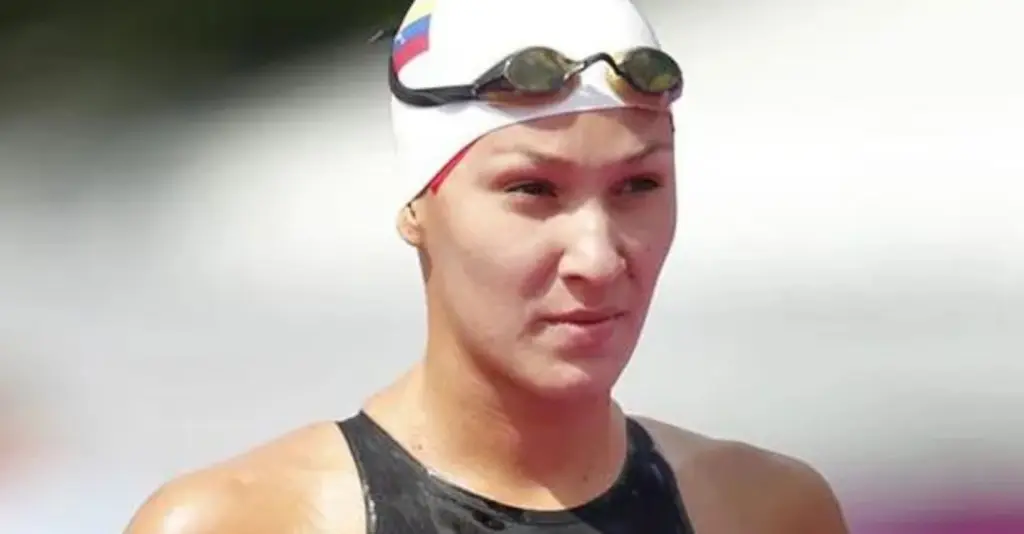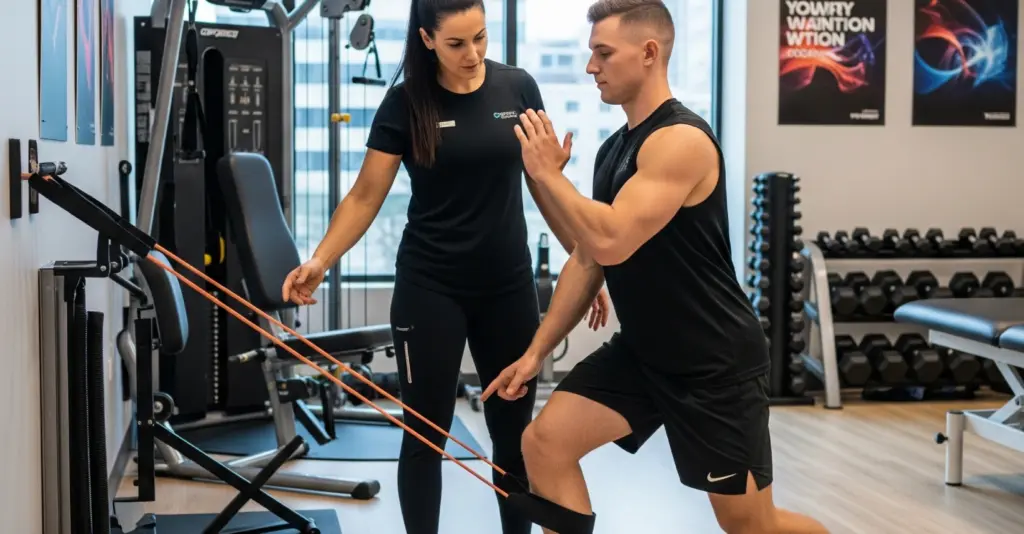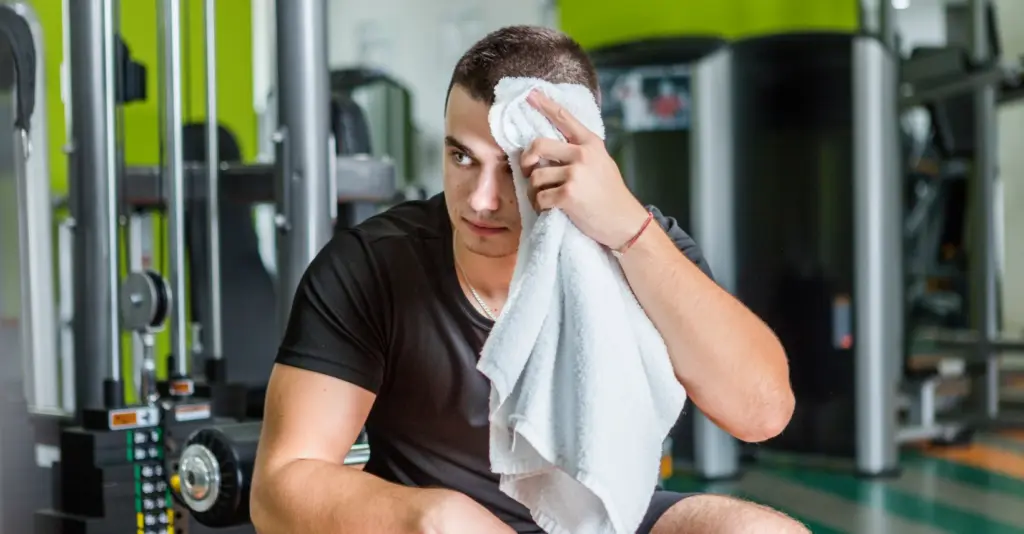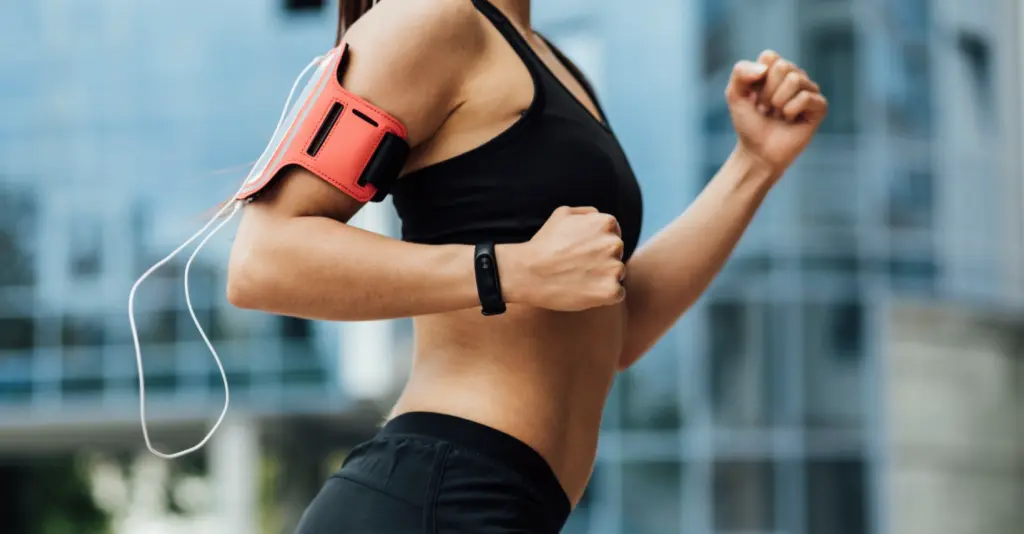Se te para el acabado de este entrenamiento?

I’m Yanel Pinto, a two-time Olympic swimmer, and I know what it means to push your body and mind beyond their limits, especially in open water. This 5K training isn’t just a physical challenge: it’s a test of focus and perseverance. Whether you’re preparing for your first race or fine-tuning for an elite competition, this set is designed to push you, build your endurance, and connect you with the essence of the sport. Are you ready to swim like an OLY athlete? Training for 5 km in open water Estimated duration: 90 minutesApproximate total: 5,200 metersObjective: endurance + orientation + competition pace Warm-up – 1,000 m 300 m gentle freestyle4×50 m (25 gentle crawl + 25 kick without board)4×50 m technique video4×25 m progressive (from slow to fast) with 15″ rest Main part – 3,500 m 3x (600 m medium pace + 1′ gentle active rest) Objective: improve competition pace and mental focus. 2. Orientation game – 800 m 4×200 m with controlled breathing + lifting your head every 6 strokes 1st every 6 strokes,2nd every 8 strokes,3rd random (every time you hear a whistle or signal from your coach, if you have one),4th bilateral breathing every 3 strokes + orientation. Imagine that you must see a buoy or a competitor nearby. 3. Work your mind – 900 m 9×100 m freestyle divided into 3 blocks: 3×100 m comfortable pace 3×100 m medium pace 3×100 m fast pace → Rest: 15” between each one, 30” between blocks Cool down – 700 m 200 m very gentle freestyle 100 m backstroke 4×50 m technique (you can use a snorkel) 200 m freestyle with eyes closed 25 m yes, 25 m no (simulates loss of visibility) Optional at the end: Mini mental challenge: float for 2 minutes without moving. Control your breathing. Visualize the finish of your 5 km race, strong, confident, and full of energy.
Consejos para Manejar el Estrés

Tips for Managing Stress When people think of physical therapy, they often imagine post-injury rehabilitation or recovery after surgery. While that is certainly an essential part of what we do, that vision is limited, especially in the world of high-performance sport.For elite and developing athletes, physical therapy is not just about getting back in the game. It’s about maintaining their best performance at all times. Extending as long and as well as possible the duration of their sporting career.Physical therapy bridges the gap between rehabilitation, performance optimization and injury prevention. In today’s era of sports science, physiotherapy is no longer reactive, it is proactive. For elite and developing athletes, physical therapy is not just about getting back in the game. It’s about maintaining their best performance at all times. Extending as long and as well as possible the duration of their sporting career.Physical therapy bridges the gap between rehabilitation, performance optimization and injury prevention. In today’s era of sports science, physiotherapy is no longer reactive, it is proactive. 1.Physiotherapy as Performance MedicineModern physiotherapy for athletes goes far beyond a treatment couch. It is a dynamic integration between biomechanics, movement science, strength and endurance training, and the specific demands of each sport. A good sports physical therapist understands the particular requirements of each discipline and tailors his or her interventions to optimize the athlete’s biomechanics, mobility and strength.For example, the physical therapist should have the ability to assist a pitcher’s performance by refining shoulder mechanics or correcting repetitive overload imbalances.A physical therapist specializing in sports should have the following knowledge: ● Analyze movement patterns and neuromuscular imbalances.● Identify asymmetries or compensations● Prescribe corrective exercises to optimize mobility, stability, and power transfer 2. Injury Prevention:The best injury is the one that never happens. Physical therapists use evidence-backed assessment tools such as the FMS (Functional Movement Screen), Y-Balance Test and sport-specific kinetic chain analysis to detect warning signs before tears, sprains or fractures occur.Many athletes are surprised to learn that:● 70% of anterior cruciate ligament (ACL) injuries are non-contact, and many stem from biomechanical deficits or fatigue.● Tendinopathies (Achilles, patellar, rotator cuff) are usually preventable with progressive loading and good recovery.Stress fractures in endurance sports are often related to faulty running mechanics, loading errors or nutritional deficits-aspects that a physical therapist can identify and correct.Establishing a preventive program tailored to the sport and the athlete’s training cycle not only decreases the risk of injury, but also improves daily recovery from microtrauma.Prevention is not passive rest, it is an active strategy. Consistency in your training turns out to be the most important factor to progress in any sport. 3. Back to Sport: Post-injury or post-surgical rehabilitation is not only about removing pain, but also about regaining confidence, explosiveness and body control. This is where physiotherapists are able to demonstrate and highlight the importance of their role in sports performance.Modern rehabilitation is functional, progressive and sport-specific. It focuses on rebuilding strength, restoring neuromuscular control and intelligently reintroducing the demands of sport. Top athletes don’t just want to return to play, they want to compete with confidence.A return to sport protocol guided by a DPT includes:Restaurar progresivamente la tolerancia a la carga. Reforzar patrones de movimiento correctos. Integrar ejercicios cognitivo-motores (tiempo de reacción, cambios de dirección, movimientos deportivos específicos) para simular el entorno competitivo. 4. Long-Term Athletic Development. In young, developing athletes, physical therapy plays a key role in building lasting movement habits. Many future injuries originate from poorly formed patterns early in training. The physical therapist works with coaches and parents to: Ensure safe progression of training loads Develop fundamental mobility and stability. Encourage appropriate recovery strategies (sleep, nutrition, tissue work) This not only helps prevent injuries, but also maximizes performance potential during the stages of greatest physical and neuromotor development. 5. Optimizing RecoveryRecovery is not just rest, it is a skill. It is where adaptations really take place. The physical therapist guides this process with manual therapy, soft tissue work, mobility techniques and recovery education.Some key tools include:● Myofascial release and manual therapy.● Joint mobilizations● Active recovery session planningComplementary therapies such as red light, cupping, dry needling, and more● Education on hydration, nutrition and sleep qualityRegular sessions with physical therapy allow you to unload accumulated stress and prepare the body to train with more quality. Having this accompaniment also helps manage training loads, improve recovery times and prevent overtraining or burnout, whether you’re a world-class athlete or someone just starting out in training. The smartest athletes don’t just train hard, they train strategically. Including a physical therapist as part of the performance team can be the difference between stagnation and evolution, between injury and your personal best. Sports success doesn’t happen by luck. It is built with precision, preparation and proactive care. And physical therapy is the foundation that allows talent to flourish.Here’s a sampling of what, in my opinion as a physical therapist, 5 exercises every runner should be doing in the gym.These are not random exercises: they are chosen for their direct transfer to running, for preventing common injuries and for optimizing movement efficiency. 1. Romanian One-Legged Deadlift Strengthens the hamstrings and glutes while improving balance on one leg. Helps to have more control in the mid-stride phase and reduces the risk of overuse injuries. 2. Bulgarian Squat Running is a unilateral movement, and this exercise strengthens the legs in a running-specific position. It improves stride efficiency, hip control and overall power. 3. Poliquin Dip Excellent eccentric exercise for the quadriceps that activates the VMO, improves knee alignment and helps prevent aches and pains such as runner’s knee. 4. Sled Push + Reverse Drag (Sled Push + Reverse Drag) Develop explosive lower body strength and strengthen knees without impact on joints. Reverse drags, in particular, help armor the quads and improve long-term knee health. 5. Anterior Tibial Raises (Tib Raises) An underrated but very important movement. Strengthens the tibialis anterior muscle, improves dorsiflexion and helps prevent injuries such as tibial periostitis. If you want to run faster, longer and without
Aprender a perder: el progreso es fruto del fracaso

Learn to lose: progress comes from failure. -When failing teaches you more than winning.-Learn to lose to keep winning.You’ve trained hard, you’ve eaten well, you’ve taken care of every detail… but the key day arrives and things don’t go as expected. The weather doesn’t improve, your leg doesn’t respond, your head fills with doubts. Frustration: that uncomfortable mix of anger, sadness and disappointment when reality does not match your expectations. It is normal to feel it, but be careful: not knowing how to handle it can take more energy than the mistake itself. Here’s a quick exercise for those moments: ● Name it: Instead of hiding it, say, “I feel frustrated today because X.” Naming the emotion lowers it in intensity.● Rephrase: Ask yourself, “What did I learn today that I wouldn’t have learned if everything went perfectly?” Example: you learned how to regulate your mind under pressure, how to deal with fatigue, how to encourage yourself after failing.● Widen your gaze: remember that progress is not linear: it doesn’t matter just one day, it matters the overall curve. One bad day doesn’t erase your progress.True progress is never failing, but learning to get up wiser each time. Just as you take care of your body, take care of your mind: learn to manage your emotions. Because true progress is not only measured in times, but in how much you grow as an athlete and as a person.Alejandra Clemente Pino,Sports psychologist, marathon runner and duathlete.I help athletes to enhance their performance, take care of their emotional well-being and live the sport as a space of fulfillment and purpose.
El Atleta de la Placa: abastecimiento de combustible Basado en la Intensidad del Entrenamiento

The Athlete’s Plate: Fueling Based on Training Intensity One of the biggest misconceptions in sports nutrition is that eating healthy is enough. But for athletes, nutrition goes beyond “eating clean”—it’s about eating smart, based on your training load. That’s where the Athlete’s Plate comes in. As a Sports Dietitian, I often emphasize the importance of macronutrient distribution—carbohydrates, proteins, and fats—based on the intensity of your workouts. Whether you’re preparing for a light recovery session or a demanding day of back-to-back training, your plate needs to reflect your energy needs. Light Training Day: Your plate should focus more on lean protein and colorful vegetables, with a moderate amount of carbohydrates. Think recovery and maintenance. Moderate Training Day: Now carbohydrates start to take more space on your plate. They fuel your muscles, support performance, and speed up recovery. Hard Training or Competition Day: Carbs become the star! You’ll need a higher proportion of complex carbohydrates to maximize glycogen stores and sustain energy throughout intense training. Carbohydrates are not the enemy—they are the primary fuel source for athletes. Restricting them can compromise both performance and recovery. Tailoring your meals to your training load ensures you’re not just fueling—you’re fueling with purpose. Do you want to take the guesswork out of fueling? Get your copy of the Athlete’s Plate Guide—designed by a Sports Dietitian and Olympian—to learn how to build the right plate for light, moderate, and intense training days.
